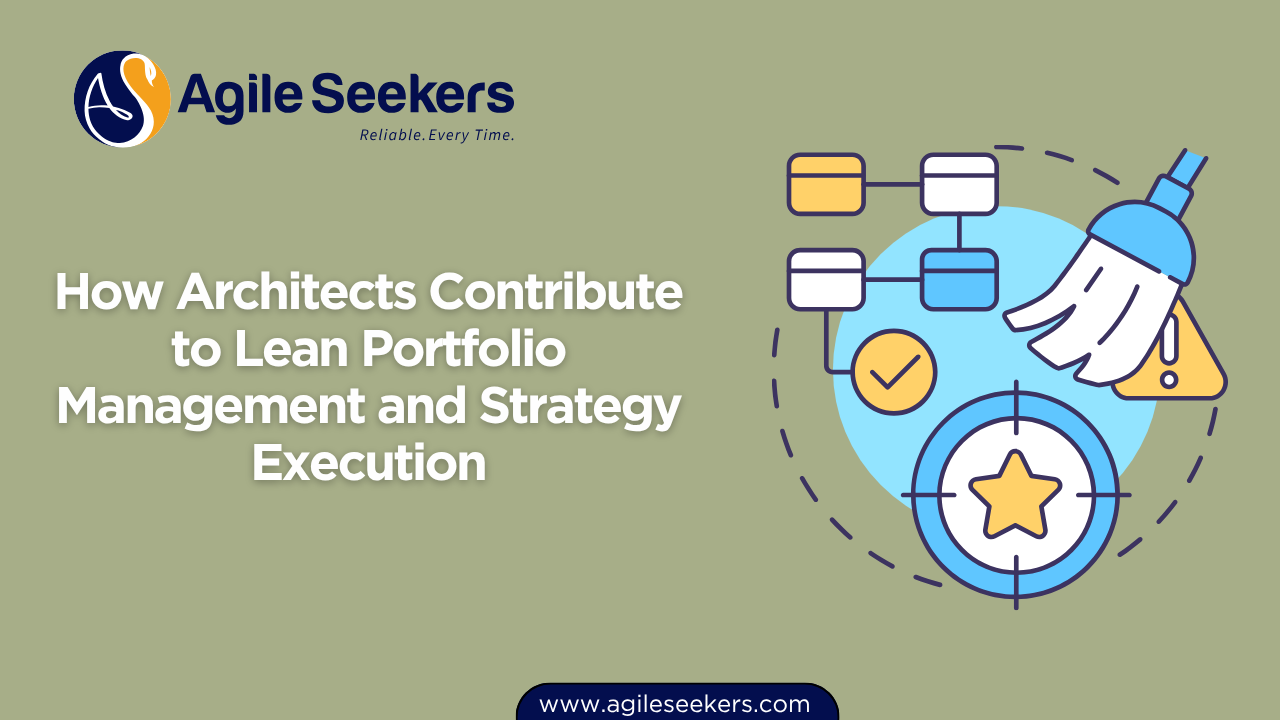How Architects Contribute to Lean Portfolio Management and Strategy Execution

In a Lean-Agile enterprise, architects play a critical role in aligning business strategy with technical execution. They don’t just make technology decisions—they help shape how organizations translate strategy into working solutions by contributing to portfolio-level alignment, guiding investment decisions, and supporting decentralized implementation.
This blog explores how architects bridge the gap between enterprise strategy, solution intent, and real-world technology delivery in SAFe® (Scaled Agile Framework).
1. Architects as Strategy Translators
Strategy without execution is vision without traction. Architects help ensure that strategic intent—whether defined through a Lean Portfolio Management (LPM) function or a portfolio Kanban—is reflected in the design and evolution of systems.
They contribute to strategic themes by identifying which technical capabilities and architectural enablers must be prioritized. This input shapes the Portfolio Backlog, aligning architectural investments with business outcomes such as time-to-market, scalability, or product innovation.
They collaborate directly with LPM stakeholders, including Epic Owners, Enterprise Architects, and Lean Budgeting decision-makers, to ensure architectural work supports both near-term value delivery and long-term technical health.
2. Influencing Investment Guardrails
One of the most underappreciated roles architects play is helping shape investment guardrails—policies that guide decentralized spending decisions. Architects help:
-
Identify systemic risks from tech debt or legacy infrastructure
-
Justify architectural enablers during epic approval or portfolio prioritization
-
Contribute data on how proposed solutions align with enterprise platforms and roadmap dependencies
This collaboration influences the strategic use of guardrails, a Lean Portfolio Management construct that balances agility with governance. Architects also help maintain the integrity of the Solution Intent—the evolving description of what a system should do—by guiding how guardrails are interpreted at the solution and ART (Agile Release Train) level.
3. Supporting Lean Budgeting with Technical Insights
Lean budgeting enables ARTs and Solution Trains to spend within agreed-upon guardrails. Architects help make this model effective by ensuring technical feasibility is considered during budgeting decisions. They offer clarity on:
-
Systemic enablers that require cross-cutting investments
-
Long-term scalability needs that could be blocked by shortsighted funding
-
Infrastructure investments that support Continuous Delivery and DevOps
They often partner with Release Train Engineers and Product Management during Participatory Budgeting events, ensuring technology investments support value stream-level agility and don’t become afterthoughts.
To understand how architectural decisions connect to delivery planning, the SAFe Release Train Engineer certification training helps highlight key facilitation practices for ART alignment.
4. Guiding Epic Hypotheses and Enabler Definition
Epics in SAFe are large, cross-cutting initiatives that impact multiple value streams. Architects contribute to their success in several ways:
-
They help define epic hypotheses by assessing the technical feasibility of new ideas
-
They design solution-level enablers that prepare systems for incremental implementation
-
They help refine MVPs (Minimum Viable Products) to balance speed with architectural soundness
When Product Managers and Epic Owners collaborate with architects early in the lifecycle, solutions can scale more effectively without being redesigned later. This makes the architect's contribution vital to the success of portfolio epics.
The SAFe Product Owner/Product Manager (POPM) certification explores how backlog items and epics are defined and prioritized with input from architecture.
5. Enabling Decentralized Execution Without Chaos
One of SAFe’s core principles is decentralizing decision-making. However, uncontrolled decentralization often leads to fragmented systems, duplicated functionality, or non-scalable implementations.
Architects help balance freedom and structure. They define Architectural Runways—foundational systems and technical capabilities that enable future features without delay. These runways are regularly evolved and extended as part of ongoing PI (Program Increment) planning.
This continuous evolution relies on close collaboration between architects and SAFe Scrum Masters, who help teams understand architectural guardrails during sprint execution.
The SAFe Advanced Scrum Master certification further explores how to facilitate team-of-teams alignment with architecture and system-level flow.
6. Visualizing and Communicating Technology Strategy
Architects play a communication-heavy role. They must translate abstract technical concepts into meaningful insights for:
-
Portfolio stakeholders
-
Business owners
-
Enterprise executives
To do this, architects use tools like capability maps, technology roadmaps, and architecture dashboards to communicate impact and readiness. This transparency is especially important when decisions involve trade-offs between technical debt, feature speed, or compliance.
Participating in Lean Portfolio events gives architects visibility and influence, allowing them to guide strategic discussions around systems evolution, DevOps enablement, or enterprise tooling.
Executives and architects who go through Leading SAFe certification training learn how to drive alignment between technical and business strategy effectively.
7. Architectural Contributions to PI Planning and Solution Delivery
SAFe emphasizes Program Increment (PI) planning as a critical synchronization point. Architects contribute by:
-
Sharing the architectural vision with ARTs
-
Outlining expected architectural enablers for upcoming features
-
Identifying cross-team dependencies that could affect system integrity
During the PI, architects work with System Teams and DevOps to validate design assumptions and ensure built solutions align with evolving architecture.
The impact of architects during PI execution goes beyond advisory roles—they are enablers of delivery velocity, security compliance, and performance resilience.
8. Creating a Culture of Continuous Alignment
The best architects are not ivory tower experts—they’re embedded collaborators. They enable a culture where:
-
Technology decisions are made close to the source of truth
-
Guardrails evolve with business realities
-
Innovation is guided, not gated
By supporting continuous learning and feedback loops across value streams, architects help enterprises remain agile and accountable.
Final Thoughts
Architects are not just system designers—they are business enablers. Their ability to connect Lean Portfolio Management with executable solutions helps organizations scale with confidence and adapt without losing cohesion.
For those new to scaled roles, exploring certifications like SAFe Scrum Master or POPM can clarify how architecture and agility work hand-in-hand. Meanwhile, enterprise leaders benefit from Leading SAFe to understand the full strategic value architects bring to the table.
For more context on Lean Portfolio practices and architectural contribution to strategy, review Scaled Agile’s LPM guidance and Solution Intent insights.
Also read - Empowering Agile Teams Without Losing Alignment
Also see - Architecting for Agility: Practices That Support Rapid Learning and Innovation




















